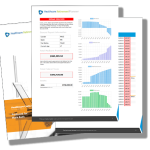Deciphering the COLA 2024 prediction is a complex task.
The landscape of Social Security benefits is ever-changing, influenced by myriad factors such as inflation and rising prices.
The COLA 2024 prediction, specifically, has financial professionals on their toes due to its potential impact on retirement planning strategies.
This year’s estimate sees an unexpected rise despite slower inflation rates – a twist that demands attention from both recipients and advisors alike.
Navigating the COLA Landscape in 2024
As financial advisors, it’s essential to keep up with potential shifts that may have an effect on your customers’ retirement plans. One such change is the predicted cost-of-living adjustment (COLA) for Social Security recipients in 2024.
The annual inflation rates, recent inflation data, and rising prices are key factors impacting this prediction. The easing of annual inflation from a four-decade high of around nine percent down to just three percent is noteworthy.
Inflation Cools but Prices Rise
Despite slower overall economic growth as indicated by June’s cooling off period, we’ve seen an upward pressure exerted by rising prices. This scenario has implications not only for current retirees but also future ones whose income will be largely dependent on social security benefits.
This year-on-year increase may seem counterintuitive given that general inflation continues at a more subdued pace than previously experienced during May’s 8% gain period. However, these dynamics underscore why understanding how various elements interact within our economy becomes increasingly important when forecasting social security cola estimates effectively starting January 2024 and beyond. USA Today provides further insights into this topic here.
The Unexpected Rise in Social Security COLA Estimates
Recent inflation data shows a slight rise in the average trailing twelve-month rate, leading to an unforeseen increase in the Social Security COLA estimate for 2024. Despite slower inflation, this figure has jumped from its initial prediction of 2.7% up to approximately 3%. More insights into these surprising shifts can be found at The Senior Citizens League.
The Role of Inflation Data
In shaping these adjustments, recent inflation data holds significant sway.
Even as signs point towards cooler rates of inflation, it hasn’t prevented the Social Security COLA estimate from exceeding its original forecast and reaching around three percent (3%). This development might seem paradoxical given that lower levels of annual inflation typically result in smaller increases.
Numerous factors come into play when formulating these estimates; even minor changes can yield substantial impacts on final figures. Therefore, it’s essential for financial professionals advising clients about retirement planning strategies to stay informed with such developments as they unfold over time.
Impact of Rising Prices on Social Security Recipients
The ripple effects of escalating prices are acutely felt by seniors who largely depend on Social Security benefits. The inflation surge, underscored notably by May’s 8% gain, has resulted in an uptick in the cost of living.
This escalation can pose significant challenges for those subsisting on a fixed income. Even marginal increases in essential costs such as food and healthcare can have substantial implications for their financial stability.
How Medicare Trustees Forecasted Monthly Part B Premiums Affect Seniors’ Bottom Line
Beyond surging prices, anticipated changes to Medicare Part B premiums, slated to take effect starting January 2024, also play a pivotal role in shaping the financial landscape for seniors.
The trustees project an increase in these premiums that could potentially offset any COLA adjustments received by beneficiaries. This might result in negligible or no net growth at all regarding their disposable income despite expected COLA hikes coming months rose slightly over previous predictions.
A key aspect of planning around this scenario involves understanding how these predicted premium alterations will interact with potential COLA rises. Financial professionals advising clients need to incorporate this into retirement planning strategies effectively starting January 2024 onwards accordingly.
Reflecting on Past COLA Increases and Anticipating Future Trends
Looking back at COLA trends can provide insight into what the future may hold. Take 2023, for instance: beneficiaries witnessed a notable surge in their benefits with an effective starting rate increase hitting roughly 8.7%. This marked one of the largest jumps since as far back as ’81.
The Transition from a Forecasted Uptick Barely Over Half at Merely 53% to an Estimated Escalation Leaving That Number Behind at Full Three Quarters
Predictions can sometimes miss the mark when it comes to estimating COLAs. The Senior Citizens League’s initial projection was only just over half – about fifty-three percent (53%). Yet current estimates have exceeded that figure significantly.
We’re now seeing forecasts leaning towards three-quarters or seventy-five percent (75%), demonstrating how fluid social security cola figures are, and emphasizing why financial professionals need to stay updated while advising clients on retirement planning strategies amidst rising prices.
No crystal ball can provide exact numbers for future years’ COLA increases due to fluctuating factors like inflation rates and living costs; however, historical data combined with recent trends serve as useful tools in making educated predictions about potential changes down the line. This is especially relevant given May’s 8% gain which could impact these calculations if inflation continues unabated despite signs that inflation cools slightly according to June data released by USA Today.
Understanding How Many Americans Qualify for COLA Increase
The population of American citizens eligible for a cost-of-living adjustment (COLA) increase is largely comprised of Social Security beneficiaries. According to the Social Security Administration’s data, approximately 65 million people fell into this category as of December 2023.
This demographic includes retired workers, their dependents, disabled workers and their dependents, along with survivors of deceased workers. Thus, any fluctuations in COLA significantly impact a considerable segment of America’s populace.
Determining Eligibility For A COLA Increase
To be deemed qualified for a Social Security COLA announced hike under the rules set by Social Security, recipients must have been entitled to benefits during December preceding the year when said increase becomes effective starting January next year. This means that those who will benefit from an estimated rise in Social Security COLA effective starting January 2024 should have already been eligible since December last year – i.e., December 2023.
However, it’s worth noting that due to varying Medicare Part B premium deductions based on income levels, not all beneficiaries experience equal percentage increases despite being partakers in the same annual inflation pool. Such nuances make it imperative for financial professionals to fully comprehend these calculations while advising clients about retirement planning strategies effectively come what may – whether June data suggests slower inflation or recent inflation data predicts otherwise.
When is Social Security COLA Announced?
The announcement of the annual Cost-of-Living Adjustment (COLA) for Social Security recipients isn’t just a date on the calendar—it’s an essential moment that affects millions of Americans and their financial planning. It typically happens in October each year.
This information comes from none other than the United States Social Security Administration (SSA). The SSA evaluates economic trends, inflation data, and various other factors to make this decision during Q3. This timing allows beneficiaries to adjust their budgets before these changes become effective starting January 2024.
Necessity For Financial Professionals
But it’s not only those receiving benefits who need to keep tabs on this crucial announcement; it also matters significantly for financial professionals advising clients about retirement strategies. Having knowledge about when these announcements are made can help advisors guide their clients more effectively by modifying plans based on potential increases or decreases in benefits.
Beyond offering insight into possible adjustments, understanding when COLAs are announced gives you a chance as a professional advisor to discuss larger market trends with your clientele. If there has been a substantial increase due to rising prices or higher-than-expected inflation rates—like we’ve seen recently with June data showing slowing but still present inflation—it could signal broader economic shifts impacting different parts of client portfolios too.
A Key To Trust And Success
Maintaining awareness around such critical announcements helps ensure your advice stays relevant and timely—a key aspect in building trust among your clientele while navigating complex financial landscapes together towards successful retirements despite any social security cola announced figures coming down the pipeline.
What’s Next? Predictions and Preparations for Financial Professionals
The future of Social Security COLA is a topic that financial professionals should closely monitor. As the United States Social Security Administration (SSA) announces its annual adjustments, understanding these changes can significantly impact your clients’ retirement plans.
In essence, as a finance professional advising clients about their retirement planning strategies, you must stay informed about predictions surrounding social security cola announced figures and understand what this means practically.
A Proactive Approach towards Retirement Planning Amid Rising Prices
To prepare for any shifts due to effective starting January 2024 announcements in social security cola figures, consider advising your clients about several strategies. These may include reassessing their budget based on new adjustment or exploring other income sources if necessary.
- Evaluating current expenses against potential increases in benefits due to an unexpected rise in COLA estimates,
- Analyzing recent inflation data which suggests slower yet persistent increase,
- Understanding how forecasted monthly part B premiums by Medicare trustees might affect seniors’ bottom line;
Predictive Analysis: The Key To Future Preparedness
Predicting future trends isn’t an exact science, but analyzing past data coupled with staying abreast of economic conditions such as rising prices provides insights into possible outcomes. This helps create robust plans, ensuring they’re not caught off guard when adjustments are made.
You need to remember that every percentage change matters, especially when dealing with those relying heavily upon benefits like many American seniors do.
Moving Forward With Confidence In Changing Times
Your role extends beyond mere advice giving; it’s also preparing them for uncertainties ahead, thus making sure they continue enjoying life without worrying too much over finances during their golden years.
Conclusion
Understanding the COLA 2024 prediction is crucial in planning for financial stability.
This adjustment can significantly impact Social Security recipients and their ability to manage rising costs.
Inflation data, although cooling off, has still led to an unexpected rise in COLA estimates from initial predictions of 2.7% up to a projected 3% increase.
Rising prices continue to affect seniors relying on social security benefits, making accurate forecasts even more critical for effective retirement planning strategies.
By analyzing past trends and future predictions, we gain valuable insights into potential increases that could influence our clients’ retirement plans dramatically.
If you’re a financial professional looking for ways to better assist your clients with these changes and navigate the complex landscape of IRMAA costs in their retirement plan – Healthcare Retirement Planner is here to help!
today! Let’s work together towards creating comprehensive and strategic solutions tailored specifically for each client’s unique needs.
Table of Contents:
- Navigating the COLA Landscape in 2024
- The Unexpected Rise in Social Security COLA Estimates
- Impact of Rising Prices on Social Security Recipients
- Reflecting on Past COLA Increases and Anticipating Future Trends
- Understanding How Many Americans Qualify for COLA Increase
- When is Social Security COLA Announced?
- What’s Next? Predictions and Preparations for Financial Professionals
- Conclusion
Streamlining the Medicare Surcharge Calculation Process.
Our Healthcare Retirement Planner software is designed to streamline the retirement planning process for financial professionals. By providing an efficient way to calculate IRMAA costs, our tool helps you save time and focus on other aspects of your clients’ retirement plans.
- Faster calculations: Our software quickly calculates IRMAA costs based on your client’s income and tax filing status, eliminating manual calculations and potential errors.
- User-friendly interface: The intuitive design of our platform makes it easy for financial professionals to input data and generate results with minimal effort.
- Data integration: Seamlessly integrate our calculator into your existing financial planning tools or CRM systems for a more streamlined workflow.
- Easy to Understand Reports: Export reports to easily share with your clients
- Tax and Surcharge Modeling: see how different types of income affects both taxes and your surcharges.
In addition to simplifying the calculation process, using our Healthcare Retirement Planner can also help improve communication between you and your clients. With clear visuals that illustrate how IRMAA costs impact their overall retirement plan, you can effectively convey complex information in an easily digestible format. This enables clients to make informed decisions about their healthcare expenses during retirement while ensuring they are prepared for any potential changes in Medicare premiums due to income fluctuations. To learn more about how our software can benefit both you as a financial professional and your clients’ retirement planning experience, visit the features page. Streamlining retirement planning processes can help financial professionals save time and resources, allowing them to focus on other areas of their clients’ needs. Automated calculation of IRMAA costs is the next step in streamlining this process even further.







